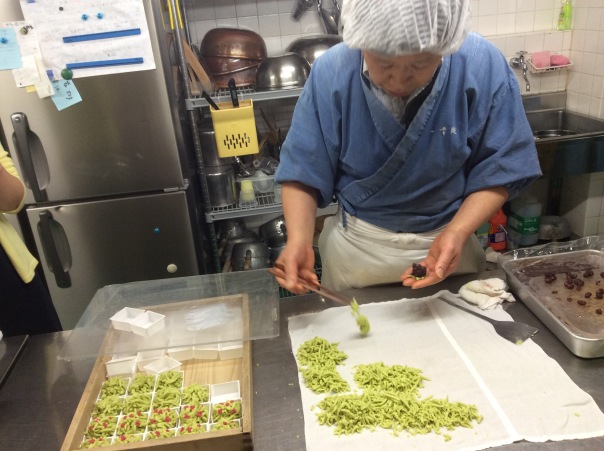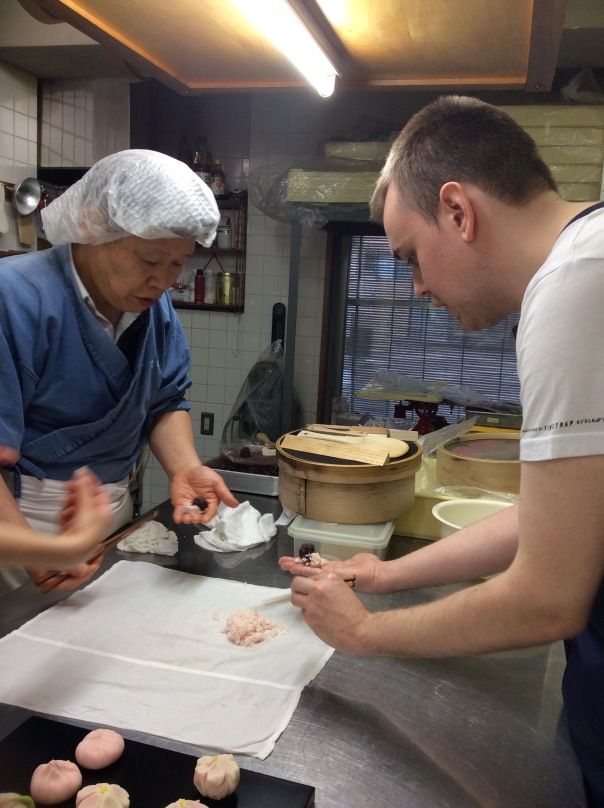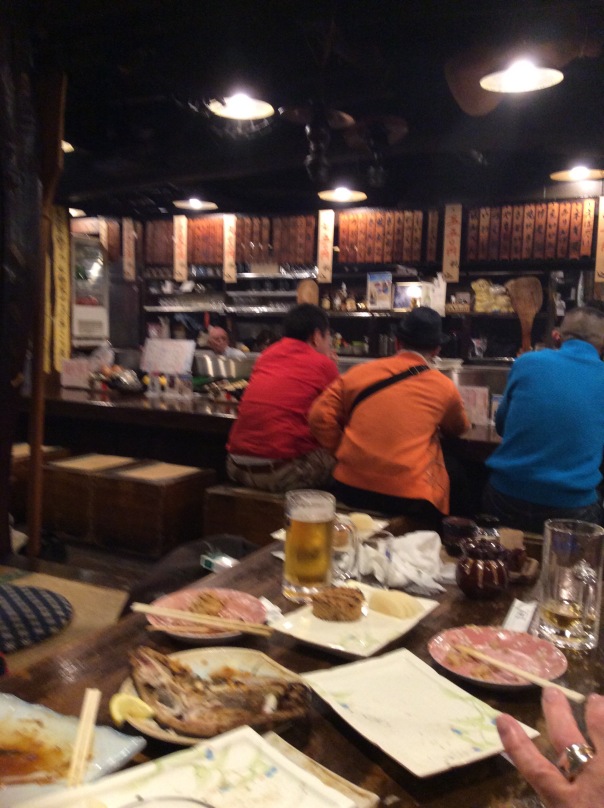“The spirit of an artisan is similar to that of an craftsman or artist. Wagashi is something that is produced rapidly, and consumed by the end of the day. In other words, because Wagashi is not something that would remain for generations, it is not usually seen under the same light as a product of a craftsman or artist, at the end of the day we are not a culture ourselves; rather we support culture from the background. All we want to do is to make the world understand the decliciousness of Wagashi and anko” humble words spoken by Chikara Mizukami.
Anko means red bean paste.
Another day of activities today in Tokyo.
This morning I went over to Mikita in order to pay my second visit to the Studio Ghibli by JR rapid Chuo line from Kanda station. This part of the journey was about 30 minutes long. Then a fifteen minute walk from the station to the museum. They do run a bus service from the station but it’s a hundred yen for one way and around 300 Yen for round the trip, that’s almost as much as it cost me to travel from Kanda to Mikita.
Plus the weather is usually nice and sunny and the park is nice enough to walk through.
Got to the museum for around 9:40am. As my ticket was for 10:00am entrance, they do different entry times, usually 10:00am, 12:00pm, 2:00pm and 4:00pm I believe. Easy enough to get tickets for it either aboard or in Japan. Aboard it’s usually a travel agent who sort it out. See the ghibli museum website for each country booking system.
In Japan you can buy tickets for the museum from Lawson’s convinient store.

Easy to spot one in most parts of Tokyo. Do note that tickets for the museum tend to sell out quite quick (especially during bank holidays that the Japanese have between April and July time) so my advise is to book your tickets before you arrive in Japan to be safe. Also book a bit later on in the day since 10:00am is quite busy.
Having been to the museum on my first trip to Japan back in 2010. I knew what to expect, the museum is still for the most part the same as it was back then. That isn’t a bad thing overall, but most people would probably want to do the place once. As there isn’t a huge amount to do there. It’s more of something to do in the morning or afternoon for an hour or two.
Also take note that you aren’t allowed to take pictures of stuff inside the building. They enforce this rule quite a bit, hence why I haven’t put up any photos inside of the museum. Since I chose to respect that rule, there are blogs where people have photoed the inside of he museum so check them out if you want to see the inside of the museum.
Another fact to note is that all the signs and information bits are in Japanese only. Shame as I would have liked to have seen what some of the info said. Especially for the special exhibition they had for the nutcracker and king mouse story they had on display.
However you are allowed to take pictures on the outside.






These were the shots I got from the outside. With the robot and cube from Laputa. Shame there isn’t more of this stuff at the museum.
Now for the inside of the museum. There is a threater where you get to watch one short animation film that’s about ten minutes long. This changes monthly I believe, last time I got a small sequel to my neighbour totoro with the youngest girl Mei meeting the grey creature again due to a small cat bus interacting with her.
This time I got a short film called House Hunting, there were no words spoken, just sound effects, quite clever and interesting to watch. But that’s what you get from Miyazaki himself.
There is also a projectionlist room where they show different parts of moving objects, one has the robot above with birds, another the villain from sprited away, and another from my neighbour totoro.
Along with a galaxy room of drawings and pictures from many Studio Ghibli films, including the later ones. Something that was lacking first time I went there so was happy about it.
The special exhibition they had going on as I mentioned before the nutcracker and the mouse king, like quite a few of Studio Ghibli productions is from a western novel or children’s tale. Now the museum has set up some pictures of telling the story with wall of text next to them.
But they have a puppet like but where if people turn the wheels below, the figures move as the bit has two armies fighting each other. I really liked how all of it was set up its a shame that it’s only in Japanese the text. As I think foreign visitors would love to know the context of the story.
It’s definitely worth visiting Studio Ghibli at least once, even if your not a fan of their stuff. It’s a nice way of passing a free morning or afternoon. Though it is a bit of a travel to get there since Mikita is a bit out from central Tokyo.
Now for the Wagashi lesson 😃.
Just a quick info bit on Wagashi sweets. Wagashi sweets are tea sweets, namely they are there to help make the tea better to drink. It isn’t like a dessert sweet, or something to eat like a dairy milk bar. There is quite a bit of how big of a role play to it when it comes to tea ceremonies.
It hardens back to the days of when the samurai were around. It’s a master/servant type relation, and the way the chef I met today applies it to his work is very much latter in Japanese culture and history.
This experience I did today was quite different from what I have done in Japan before, it isn’t the usual tourist stuff. It’s quite a specialist experience.
When I first saw it on InsideJapan experience page on their site. I thought they this would be an interesting thing to do, since Japanese tea sweets was something I had little knowledge of.
Once Rachel my travel consultant got back to me about it, saying that it would be with a famous chef, one of the top five in the world. Then I was determined to do it. As I would find out this is a very Japanese experience, one that even the Japanese themselves would find interesting since it’s that deep in Japanese history and culture.
The Interpretors I had (Yuko Inamasu and her fellow worker whose name i have forgotten, sorry not good at remembering names 😔) themselves at times really found it quite insightful, especially when it came to some of the more history bits of the difference between Edo Wagashi and Kyoto Wagashi.
They do quite a bit of this sort of experience so if you ever want or need someone to do interpretation or just offer you some great ways of seeing Japanese culture give her a call or check out her company website http://toki.tokyo/ I believe it is but google it to be safe. Named after a bird in Japan that means time, you can guess what the deeper meaning of it all is.
Now some info on the chef in question. His name is Chikara Mizukami.

He has been making Wagashi sweets for over fourty years. Having found his shop in 1977. He has been sought after by some famous confectionary makers over the years such as Sadaharu Aoki and Jane-Charles Rochoux.
Now Chikara has quite a philosophy to the way he makes Wagashi sweets. Since there are to my surprise 72 seasons throughout the year. He will each season that changes every few weeks cater his making to each season that is ahead. As showed me in the book he is currently writing that outlines his style and way of making sweets. With the current one being Sakura sweets due to as you can guess the Sakura season.
Now one of the abilities of Chikara is that when each seasons come around he won’t just make the sweets, he will use the essence of Japanese cultures and traditions in order to make and showcase the seasons of sweets he is making.
So for example, on Valentine’s Day he took a poem from Hyakunin Isshu (a Classical Japanese anthology of one hundred Japanese waka by one hundred poets). That indirectly expresses the feeling of love, and visually realized it as a Wagashi looking like green petals with white powdered snow.
He also uses elements of influences from fine art and even architectural work. Even using influences from European artists like Monet. Chikara is a man who finds inspiration in all time periods.
Some of the above came from info my travel consultant Rachel Rykala in my info pack for adds on she sent me. The rest from the man himself.
Now let’s talk about the lesson I had. Sorry for the long stuff above but the above can be helpful in understanding how my lesson went, as well as give a few details on a very Japanese custom most people in the west have never heard of.
First we started off with Chikara talking and showing us (me and the Interpretors), the art of making Wagashi and showing how Edo style Wagashi and Kyoto style differ. With Edo style being direct in reflecting how the shogun and the samurai based there tended to interact and how they dealt with each in a way.
While in Kyoto where the emperor was based for hundreds of years til when the emperor at the time moved to Edo. As the power was in a sense handed to them (Emperors for most of Japan’s history were divine figures not rulers), and the city become Tokyo (which means eastern capital).

I’m sure you can tell which style the sweets are in the picture.
Then we got down to making some, starting with the direct style. As I found out it’s a lot harder than it looks. First you have to roll and flatten the white ball in both of your palm hands.

It’s so the pink/brown sweet bit will fit in it, so that with the upper part of your thumb (not the top thumb part itself but the upper bit of it) so that the White/brown part covers around it. It took forever for me to get that part, but thankfully Chikara was very patient and most helpful with me. Plus it was quite funny to have to get the golf balls out to learn it 😅. But it was very fun learning that bit overall and watching Chikara do it so easy, made me appreciate even more of the honour he was giving me that afternoon.

Then once that part was done, we then combined the White and pink parts together so the Wagashi sweet become the Sakura season. This part I also struggled with as again much harder then it looks to do. As you gave to hold it with four fingers and use your thumb to mush it together, to make it into the shape you see in the pictures above.





Once that is done and the ball is all together, then Chikara showed me how using a ruler type equipment press gently on the ball to make it into the five part shown in the sweet picture by pressing it downward way for direct. This part I did well and got right, so quite happy at that 😄.
For indirect style using the aid of a towel. He showed putting the sweet into it and holding it with here fingers at the bit where it is, you press it very gently onto the table to make it indirect style. I find it hard to press gently to anything due to how my hands are tend to be like namely rough and really sensitive.



Me in deep thought and action 😏.
Finished it off by putting the yellow flower in too, this I did as well 😋. Don’t think you need to guess which ones are mine below.


Don’t think you have to guess which ones are mine 😋.
Now for the Sakura Wagashi style.
This one is more advanced.
This time was the use of the bean, and below us cut down bits of the sweet that makes up of the decoration of the Sakura Wagashi sweet.
Then the next step was Chikara using the bowl above (that’s made of horsehair and a mix of a few other things). To cut down the Sakura bits for the indirect style.
And with the aid of chopsticks showed me how by stuffing it around the combined ball you make the interest sweet leaving no parts uncovered.





All of this while holding the ball in your four fingers 😃.

Ta da the results of the our lesson. I felt I did Sakura style all right.
Chikara asked me why I chose to do this lesson. I told him that I felt it was because overall after reading his philosophy on making the sweets. How he approaches his craftsmanship with such a humble and insightful way, it was fascinating of learning from a person that has a very unique view and really relates to Japan’s rich culture and ideas. All the while making sweets deciduous and the tea even better.
Final thing we did was have a nice cup of green tea with the Wagashi. Now I tend to don’t do hot drinks in general, but I really wanted to see for myself the effects of Wagashi in tea. It really did help to make the tea even better, and I have had green tea before and it was nice. But the Wagashi really sweetens and enhances it so well. Though we are talking about a top chefs sweets here so take my words not too seriously.
To round off the lesson I had a photo taken with Chikara and his two apprentices he is currently teaching. They helped a bit throughout the lessons and the intreptors as well.

Then had a photo with the man in his shop called Ikouan based in Myogadani in Tokyo. Go to Myogadani station via maranochi line to get there. Don’t worry hadn’t forgotten giving my readers the place of where to try the Wagashi sweets.

After that he gave me some sweets and we bid farewell to each other.
The girls led me back to the station so I could get back to hotel in time to meet the group. as I said before they were fab throughout the lesson, sorry forgot to get a photo with them.
So got back to hotel by 7pm got my cowboy boots and hat on, and met the group.
Mostly English but two Americans, two Canadians I believe. Scottish couple and a guy from Portugal to round it all. All of them part from the guy from Portugal are retirement age but they all seem nice so far, mostly talked to the Scottish couple and Luis the guy from Portugal. Scottish couple haven’t got round to knowing their names yet and of the other tour people apart from a few like judith, Mary I believe and Bill I think along with Steve our tour leader.
After introductions were done we head out for dinner to local place. Where we had grilled food done that include,used tayaki fish if I remember right. Prawn, grilled chicken. Peppers,rice cakes and other food as well. Big meal.

Yeah these foods above.
Once that was done most went back while me Steve and Luis went out to the bars for a few drinks (I kept to juices being a tee total), met some nice Japanese people and two Aussie girls in the first place, second was a small quirky place with nice Victorian chairs. Learned Steve comes from Southampton and his parents live where i did in hedge end when I lived there as a kid.
Met some cool Japanese people while I was there wishes I had more time to get to know them but was really exhausted by that point and needed sleep.
Long blog post this time. But that’s mainly cause the Wagashi lesson was so good and had much to tell for that.
Hope you have enjoyed reading this blog chapter and get to try Wagashi sweets and know a bit about the sweets and its purpose in japanese culture and tradition.
Edit 20/04/15 made some corrections I spotted this morning. Had proofread it last night but I was tired and I am doing this blog off my iPad app for WordPress as well and can’t see any word proof check on it. If I make any mistakes let me know. Also put in proper link to Toki website.
Oli simpson